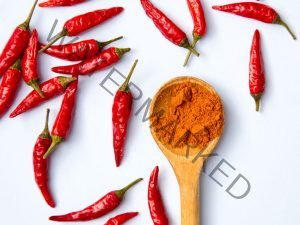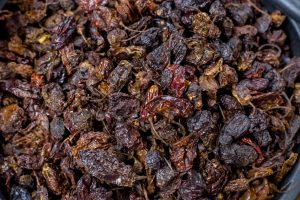Today, we will be looking at the different types of Nigerian pepper and their uses. In Nigeria, Pepper is an essential ingredient, adding heat, flavor, and depth to a wide variety of dishes.
Also, there are several types of pepper, each with its unique characteristics and culinary uses. Today, we will show you some of the most popular types of Nigerian pepper and how they are used to create the rich, vibrant flavors that are the hallmark of Nigerian cooking.
Some of this peppers you can differentiate them with their sizes and colours while some you can not. To help you further kindly continue reading to know how to tell the difference between the different types of peppers we have in Nigeria.
Now, let’s run through the common types of pepper in Nigeria.
1. Atarodo (Scotch Bonnet Pepper)

Number one on our list is Atarodo, also known as Scotch Bonnet pepper, is one of the most commonly used peppers in Nigerian kitchens. This pepper is famous for its intense heat and fruity flavor, making it a staple in many spicy dishes. Atarodo is often used in soups, stews, and sauces, where it adds a robust heat that elevates the overall taste. It’s a key ingredient in popular Nigerian dishes like pepper soup, jollof rice, and ofada sauce.
Uses:
- Pepper Soup: Adds a fiery kick to this comforting dish, often made with fish, meat, or chicken.
- Jollof Rice: Enhances the flavor profile, giving the dish its signature spicy taste.
- Ofada Sauce: Essential in creating the rich, spicy sauce served with ofada rice.
2. Tatase (Red Bell Pepper)

Before writing this article I can’t even tell the difference between Tatase and Shombo. Tatase, or red bell pepper, is another vital pepper in Nigerian cuisine, known for its mild heat and sweet flavor. Unlike the Atarodo, Tatase is not particularly spicy, which makes it perfect for adding color and subtle flavor to dishes. It’s often blended with other peppers to create a rich, flavorful base for stews and sauces.
Uses:
- Tomato Stew: Blended with tomatoes and onions to create the base for many Nigerian stews.
- Efo Riro: Used in the preparation of this spinach-based dish, adding color and a hint of sweetness.
- Moin Moin: Adds color and mild flavor to this steamed bean pudding.
3. Rodo (Habanero Pepper)

Rodo, or habanero pepper, is known for its fiery heat and fruity undertones. It is similar in heat level to Atarodo but has a slightly different flavor profile. Rodo is often used interchangeably with Scotch Bonnet in various Nigerian dishes, especially when a spicy kick is desired.
Uses:
- Egusi Soup: Contributes to the heat and depth of flavor in this melon seed-based soup.
- Suya Spice Mix: Ground and mixed with other spices to create the spicy rub for suya, a popular street food.
- Pepper Sauce: Often blended to make a spicy dipping sauce for snacks like puff-puff or akara.
4. Shombo (Cayenne Pepper)

Shombo, also known as cayenne pepper, is a long, red pepper that is moderately hot and commonly used in dried or powdered form. It’s a versatile pepper that adds a consistent heat to dishes without overpowering them. Shombo is particularly popular in making pepper flakes or powder, which are used to season a variety of dishes.
Uses:
- Seasoning: Used in powdered form to spice up dishes like fried rice, yam porridge, or akara.
- Grilled Meats: Mixed with other spices to create a marinade for grilled meats and fish.
- Pepper Flakes: Dried and crushed to make pepper flakes, which can be sprinkled on almost any dish for added heat.
5. Uziza Pepper

Uziza pepper is a small, black pepper that is slightly pungent with a sharp, peppery flavor. It’s often used in Nigerian dishes that require a more intense and aromatic spice. Uziza is popular in southeastern Nigeria and is often paired with other traditional ingredients to create authentic, local flavors.
Uses:
- Ofe Nsala: Essential in making this white soup, providing a distinctive spicy kick.
- Ukodo: Adds depth and warmth to this yam and pepper soup, commonly eaten in the Delta region.
- Pepper Soup: Uziza leaves are also used in pepper soup to enhance its flavor.
6. Cameroun Pepper

Cameroun pepper, a dried and smoked pepper, is known for its deep, smoky flavor and intense heat. It is often ground into a fine powder and used to add a bold, spicy note to dishes. This pepper is popular in the preparation of dishes that require a strong, smoky flavor, often replacing or complementing fresh peppers.
Uses:
- Smoky Jollof Rice: Adds a rich, smoky flavor to jollof rice, giving it a distinct taste.
- Stews: Blended into stews and sauces to provide heat and depth.
- Seasoning: Used in spice blends for meats, soups, and grilled dishes.
7. Bird’s Eye Chili (Ose Nsukka)
Ose Nsukka, or bird’s eye chili, is a small but potent pepper native to Nigeria. Known for its extreme heat, it is often used sparingly in dishes where a little goes a long way. This pepper is particularly popular in eastern Nigeria and is often dried and used in powdered form.
Uses:
- Pepper Soup: Adds a sharp, intense heat to this traditional soup.
- Spice Mixes: Ground into powder and mixed with other spices to create a fiery blend for various dishes.
- Local Delicacies: Commonly used in local delicacies, where its heat complements the rich, earthy flavors.
8. Alligator pepper (Grains of paradise)
Alligator pepper is an excellent choice for enhancing pepper soups, as it infuses the dish with a delicate floral aroma, reminiscent of jasmine, cardamom, and clove. In rice dishes, it imparts a refreshing blend of menthol and eucalyptus fragrances, elevating the overall flavor profile. Additionally, alligator pepper lends a distinctive peppery aroma to fish and meat, making it a perfect seasoning for grilling or cooking.
Health Tip: Alligator pepper isn’t just a flavorful spice—it also offers medicinal benefits. The seeds are known for their anti-inflammatory properties, while the long leaves are traditionally used to treat ailments like measles and gastrointestinal issues.
9. Black pepper
Black pepper is derived from the berries of the Piper nigrum plant, renowned for its spiciness, which is attributed to piperine, rather than capsaicin, as found in cayenne and habanero peppers. Its taste is hot, sharp, and biting, complemented by a peppery scent with woody, piney, and citrusy undertones. These aromas and flavors become even more pronounced when the peppercorns are freshly ground.
The depth and pungency of black pepper make it an ideal spice for pepper soups, particularly when paired with alligator pepper. It adds an aromatic richness to traditional Nigerian soups like egusi and vegetable soup. For seasoning meat and omelets, a blend of black pepper and alligator pepper with salt creates a robust, flavorful combination.
In addition to its use in savory dishes, black pepper lends a gentle spiciness and subtle bitterness to baked goods, such as bread, cakes, and cookies. Its peppery-bitter flavor helps to balance and reduce excessive sweetness in biscuits and other baked treats.
Beyond its culinary applications, black pepper offers notable health benefits. The active compound piperine is known to help eliminate harmful molecules in the body that could lead to heart disease and diabetes. While human trials are still limited, research suggests that black pepper and piperine may possess cancer-fighting properties, making it a valuable spice not only for its flavor but also for its potential health benefits.
10. White pepper
White pepper and black pepper both originate from the berries of the Piper nigrum plant. The key difference lies in the processing: white pepper is produced by removing the outer layer of the pepper berry before drying. This method gives white pepper its distinct flavor and a milder, more refined taste compared to black pepper. It carries an intense earthy note, with a subdued spiciness and subtle touches of mustiness.
White pepper is particularly well-suited for use in light-colored sauces, soups, and dishes where a subtle flavor with earthy undertones is desired. It’s an excellent choice for enhancing the taste of pepper soup, mashed potatoes, and creamy sauces without overpowering the dish’s natural flavors. Its gentle spice and unique aroma make it a versatile seasoning in the kitchen, perfect for adding depth to a wide range of recipes.
11. Bawa (Paprika)
Bawa, commonly known as paprika in Nigeria, is a sweet, mild pepper used more for its color than its heat. This pepper is not native to Nigeria but has been widely adopted into Nigerian cuisine. Bawa adds a vibrant red color to dishes and a subtle, smoky flavor, making it a favorite for enhancing the visual appeal and taste of foods.
Uses:
- Garnishing: Sprinkled over dishes like fried chicken or jollof rice for a pop of color.
- Smoky Flavor: Added to stews or sauces where a smoky undertone is desired.
- Meat Rubs: Used in spice rubs for meats, especially in barbecue or grilled dishes.
Conclusion
Nigerian peppers are an integral part of the country’s culinary identity, each bringing its unique flavor, heat, and aroma to the table. Whether you prefer the fiery kick of Atarodo, the mild sweetness of Tatase, or the smoky depth of Cameroun pepper, there’s a Nigerian pepper to suit every palate and every dish.
Understanding the different types of Nigerian peppers and their uses can greatly enhance your cooking, allowing you to create authentic Nigerian dishes that are rich, flavorful, and true to their roots. So next time you’re in the kitchen, don’t hesitate to experiment with these vibrant peppers and discover the magic they bring to your meals.
![How To Buy Farmland For Investment [Farmer’s Guide]](https://agrolearner.com/wp-content/uploads/2024/01/Farmland.jpg)


